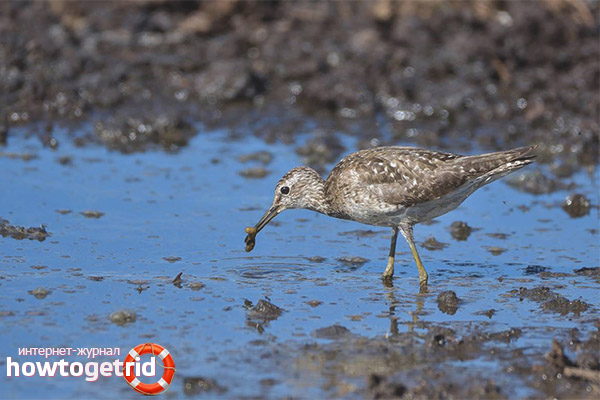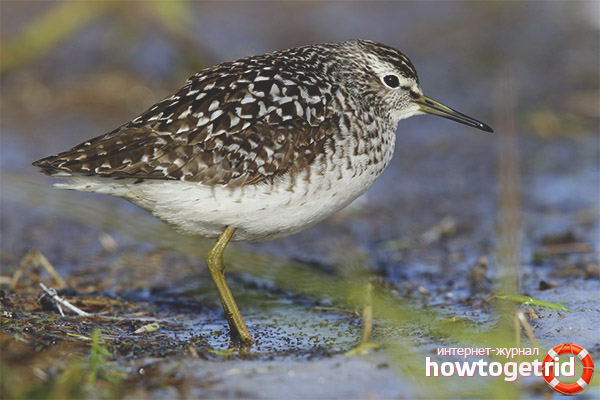The content of the article
Fifi means migratory bird, which is distributed in flooded flat areas, marshy areas and other areas with high humidity. In the winter, these individuals travel to warm climatic regions, whether it be South Asia or Africa. When migration begins, members of the family stray in packs or fly alone. But we will not run ahead, revealing the cards, so that after the information received you have your own opinion about these feathered inhabitants.
Description
- Adult individuals during mating season acquire beautiful plumage. It looks brownish in the upper section of the hull. Against this background, marks and stripes of a shade close to the main color flaunt. The back is dark, as are the wings and shoulders. The lumbar region is light, so the contrast is clearly visible. There are no sharp boundaries between the whitish lower back with a nuftail and a darkish back.
- The area behind the neck and the parietal parts are pigmented by dark oblong stripes. In the area of the base of the beak above the eyes there is a mark of white color, it is long, extending beyond the eyes. The head is painted on the sides with alternating brown and light stripes.
- The tail wings are long. The abdominal part is light, as well as the neck and chin. The chest is white, on it there are stripes of a contrasting undertone. The wings are light, but they can be patterned in the form of stripes. The tail can be rounded or pointed.
- Long legs are not too light, but not dark. They are rather yellowish or olive, faded. When the bird is in flight, its legs protrude beyond the edge of the tail. As for the shade of the eyes, they are brownish. The beak is dark, rather black. Between the middle fingers there is a membrane.
- When the birds mature and prepare for wintering, they change their plumage. It becomes brown with grayish marks. The neck in the front and sides is gray with a purple-red tint. The same colors are visible on the chest. All other areas are covered, as in the summer.
- Birds that have grown up to about a year are slightly covered with red-violet feathers in the upper part. Black marks can be observed, as well as numerous reddish blotches. Birds become black-like. The upper part of the head is black with stripes of buffy tone. The lower part of the body of young animals is colored like mature animals in winter.
- It is worth noting that the individuals under consideration pass a narrow strip of black from the beak to the eye. Also, a black thin strip can be observed over the eyebrows of a light shade. On the white area of the chest, a plaque of a dirty color can be observed. You can also notice that these birds have gray-olive legs.
- If we compare the fifi with black, you can see that in the first case, the individual has a very mottled and lighter top. It is not very different in color from the suprapochis and lower back in white. You can also notice that a light eyebrow extends beyond the eye. It is long and comes from the beak.
Nutrition

Often, the basis of nutrition of the considered individuals includes all kinds of insects that live in the aquatic environment. Moreover, such birds often regale themselves with fry, larvae, worms, mollusks and tadpoles. Fifi also includes small amphibians.
Breeding
- In most cases, the birds in question fly to nesting sites at the end of winter, if it is warm, or in early spring. As soon as individuals migrate, pairs begin to form in these places. After mating games and mating, birds begin to equip their nest.
- They find the right place in the bushes, tall grass and small trees. Next, the couple is engaged in the construction of a nest. In one clutch, the female is able to bring up to 5 eggs. The process of landing takes about 3 weeks. After this, young animals hatch in the light.
- Often, the female does not sit out to the end, in this case the male takes her place. After the birth of young animals, he also continues to engage in their education. After another 1 month, the chicks gradually begin to become winged. They gain independence. Birds reach puberty at the age of 2-3 years.
Interesting fact
The surprising fact is that the female does not always wait for the start of the appearance of the chicks in the light, she simply leaves the clutch. In this case, the male comes to the rescue and continues to hatch eggs. Only because of this, the youngsters survive.
Today we looked at fifi, a small bird with special external data and a clear voice. Individuals of this breed group live in humid climatic conditions. They are seduced by marshy areas, flooded plains and other places of such a plan.
Video: fifi (Tringa glareola)










Submit